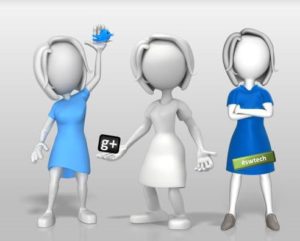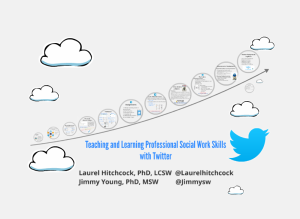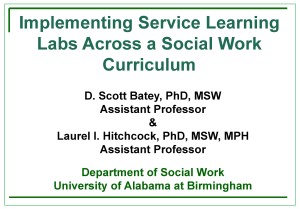Creating an Infographic in a Social Work Course: A Student’s Perspective from Danielle Davis
Last year, Dr. Nathalie P. Jones, from the Department of Social Work at Tarleton State University, wrote a blog post about her experience with a tech-meditated assignment for her social work courses – creating an infographic. She frequently uses technology in her classrooms to help students improve their digital literacy skills, and specifically uses infographics as tools for digital storytelling. As a follow-up to Dr. Jones’ post, I asked one her students, Danielle Davis, to share her thoughts on the assignment, what it was like to create an infographic, and how the knowledge and skills from the assignment might be incorporated in her future role as a social worker. Here are Danielle’s responses to my questions:
What were your initial reaction to the infographic assignment?
I was very hesitant when Dr. Jones initially discussed the infographic assignment in our service learning course. It was the second week of my social work undergraduate program, and I remember wondering if anyone else was as confused as I felt in that moment. I was worried about not being able to complete the assignment according to the grading rubric. I had never created an infographic before, however, I was willing to try. The infographic assignment allowed me the opportunity to be creative and share the information learned about working with vulnerable populations. Being able to use my creative side in an assignment was very appealing.
How did your reaction change over the semester?
Over the semester my reaction to the assignment changed entirely. As we worked on the various steps in the assignment, I started to gain a better understanding about the importance of an infographic and how they can be used. The infographic assignment ended up being my favorite assignment. I enjoyed being able to take a social work issue that mattered, build the infographic that reflected real statistics, and then share the information in Twitter to a large, public audience. I was amazed that people from all over the nation could come together in one place on social media and share information about social work by using infographics.
The Shared Case Study: An online activity for Interprofessional Teamwork
Natalie Curry, LCSW is a Clinical Instructor at Missouri State University’s (MSU) School of Social Work. She has been on the faculty with MSU for two years and prior to that was an adjunct instructor for MSU, Drury University, and Washington University in St. Louis. Prior to entering academia, her practice background includes working with individuals who were homeless in various capacities, inpatient psychiatric care, and behavioral health consulting in primary care. In this post, she writes about an online, interprofessional learning activity that she helped to develop and implement with colleagues at MSU You can follow Natalie on Twitter at @natalielcsw.
Last fall, there was considerable interest around interprofessional education in the College of Health and Human Services (CHHS) at Missouri State University (MSU), where I work. My colleagues and I believed that we were doing well at talking with our students about how much collaboration they would do in their careers with other healthcare professionals. But we wanted to go further and figure out ways to provide the students real opportunities for interprofessional practice in their educational programs. That was part of the motivation for bringing together faculty from all 11 disciplines (such as social work, nursing, medicine and others) within CHHS, in addition to the University of Missouri-Kansas City School of Pharmacy which was already in partnership with MSU. The other part of motivation was a growing recognition that interprofessional activities were no longer just encouraged in many of our disciplines’ accreditation standards; they were required.
Starting in Fall 2015, our committee to begin developing interprofessional educational activities for our students. We met monthly and eventually decided that it was not feasible to develop one activity, project, or experience that all students from CHHS could do together and still be meaningful. We decided on four “menu items” that each discipline could choose to participate in, depending on the needs of their students. We wanted to have a mix of interprofessional activities, ranging from one-day experiences to projects that could be implemented over the course of a semester.
Revised Technology-Based Learning Task List for Social Work Education
 Back in April 2016, Melanie Sage, Nancy Smyth, and I first shared a list of technology-based learning activities that we developed based on Council on Social Work Education’s Social Work Competencies from the 2015 Educational Policy and Accreditation Standards (EPAS). The purpose of this list is to help social educators infuse learning about and with technology across the social work curriculum. We have updated our list to keep with the evolving understanding of how to apply CSWE’s 2015 EPAS. Here are the main features of the list:
Back in April 2016, Melanie Sage, Nancy Smyth, and I first shared a list of technology-based learning activities that we developed based on Council on Social Work Education’s Social Work Competencies from the 2015 Educational Policy and Accreditation Standards (EPAS). The purpose of this list is to help social educators infuse learning about and with technology across the social work curriculum. We have updated our list to keep with the evolving understanding of how to apply CSWE’s 2015 EPAS. Here are the main features of the list:
– Over 100 different example assignments and learning tasks with brief directions that can be incorporated into social work courses across the curriculum.
– Assignments are designed to encourage students to share their work with a class/seminar or practicum field instructor.
– For assessment purposes, each assignment and learning task is grouped by competency and component behaviors, and then labelled with the relevant competency dimensions using the following key: K = Knowledge; V=Values; S= Skills; and CA = Cognitive and Affective Processes.
You can access the new version of the list here: Technology-Based Learning Task List for Social Work Education (Version 1.1 – 6/13/16)
#SWDE2016 Teaching & Learning Professional Social Work Skills w/ Twitter
 On Day Two of the Social Work Distance Education Conference, I will be presenting a workshop about the work Jimmy Young and I have done with Twitter in the classroom. If you are at the conference today, please join me in the B& O Room at 3:45 PM for the workshop. Our work focuses on the growing awareness that Twitter, a micro-blogging social media platform, can be a valuable tool in social work education to help students develop and practice social work competencies. This workshop will inform participants about the development, implementation and assessment of different assignments using Twitter for teaching social welfare policy and macro social work practice. Sample assignments, practical tips and a demonstration of Twitter will be provided to participants. The learning objectives for the workshop include:
On Day Two of the Social Work Distance Education Conference, I will be presenting a workshop about the work Jimmy Young and I have done with Twitter in the classroom. If you are at the conference today, please join me in the B& O Room at 3:45 PM for the workshop. Our work focuses on the growing awareness that Twitter, a micro-blogging social media platform, can be a valuable tool in social work education to help students develop and practice social work competencies. This workshop will inform participants about the development, implementation and assessment of different assignments using Twitter for teaching social welfare policy and macro social work practice. Sample assignments, practical tips and a demonstration of Twitter will be provided to participants. The learning objectives for the workshop include:
1.Understand how the social media platform Twitter can be incorporated into assignments for social work courses to advance learning of the profession’s competencies.
2. Demonstrate how social work educators can assess attainment of competency among students using a social media assignment paired with a rubric for evaluation of the assignment’s learning outcomes.
3. Appreciate the role of professional collaboration in the development, implementation and assessment of social media-based assignments.
Here are some of the resources from the workshop:
Prezi Slides – Teaching & Learning Professional Social Work Skills w/ Twitter Workshop
How to Participate in a Live Twitter Chat – Tips for Social Workers
Service Learning Labs: Integrating experiential learning across a BSW Curriculum – #BPDTX16
 Day 4 of #BPDTX16 for me and my last presentation will be at 9:30 AM today. I will be talking about the work I have been doing with my colleague, Dr. Scott Batey, along with many other partners at UAB and in the Birmingham community. Unfortunately, Scott was not able to attend BPD this year, but he feels confident I won’t mess up the presentation. For our session, we really wanted to highlight the development of service learning labs in our BSW curriculum as a case study, hopefully offering tips and ideas for others wanting to incorporate more service learning into their assignments, courses & curricula.
Day 4 of #BPDTX16 for me and my last presentation will be at 9:30 AM today. I will be talking about the work I have been doing with my colleague, Dr. Scott Batey, along with many other partners at UAB and in the Birmingham community. Unfortunately, Scott was not able to attend BPD this year, but he feels confident I won’t mess up the presentation. For our session, we really wanted to highlight the development of service learning labs in our BSW curriculum as a case study, hopefully offering tips and ideas for others wanting to incorporate more service learning into their assignments, courses & curricula.
Here are the learning objectives for the session:
1. Understand how to plan and engage multiple partners in developing a curriculum-based service learning project to support student and community outcomes.
2. Determine how educators can duplicate the planning process for curriculum-based service learning projects at their own institutions.
3. Appreciate the role of professional collaboration in the planning and development of service-learning projects across a curriculum.
You can access a copy of the slides here: https://www.slideshare.net/secret/5GRJ7Qx3hVLzuG




